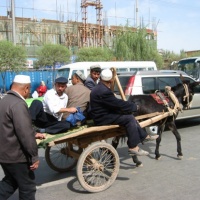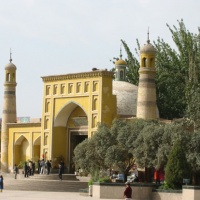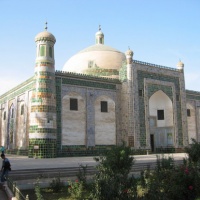Kashgar
 Kashgar or Kashi (officially transliterated as Kaxgar in Uyghur) is an oasis city in the Xinjiang Uyghur Autonomous Region of the People's Republic of China. Kashgar is sited west of the Taklamakan Desert at the feet of the Tian Shan mountain range.
Kashgar or Kashi (officially transliterated as Kaxgar in Uyghur) is an oasis city in the Xinjiang Uyghur Autonomous Region of the People's Republic of China. Kashgar is sited west of the Taklamakan Desert at the feet of the Tian Shan mountain range.
History
The earliest mention of Kashgar is when the Chinese Han Dynasty envoy traveled the Northern Silk Road to explore lands to the west. Kashgar is a important hub on the Old Silk Road, a vibrant Islamic centre within Chinese territory. Kashgar Has a history of more than 2'000 years. Kashgar was known in the West until the earlist reference appeared in Persian documents referring to an alliance of Tushlan tribes, who founded their capital here. The country's people practised Zoroastrianism and Buddhism before the coming of Islam.
 During the time of Emperor Ai 6 BC-1 AD and Emperor Ping 1-5, the principalities of the Western Regions split up and formed fifty-five kingdoms. Wang Mang, after he usurped the Throne in 9, demoted and changed their kings and marquesses. Following this, the Western Regions became resentful, and rebelled. They, therefore, broke off all relations with the Middle Kingdom and, all together, submitted to the Xiongnu. In the first century AD, during the Han Dynasty, China lost its power over the Tarim Basin. The great General Ban Chao was dispatched to subdue the wild kingdoms of Silk Road that had aligned themselves with the Xiongnu against the Chinese.
During the time of Emperor Ai 6 BC-1 AD and Emperor Ping 1-5, the principalities of the Western Regions split up and formed fifty-five kingdoms. Wang Mang, after he usurped the Throne in 9, demoted and changed their kings and marquesses. Following this, the Western Regions became resentful, and rebelled. They, therefore, broke off all relations with the Middle Kingdom and, all together, submitted to the Xiongnu. In the first century AD, during the Han Dynasty, China lost its power over the Tarim Basin. The great General Ban Chao was dispatched to subdue the wild kingdoms of Silk Road that had aligned themselves with the Xiongnu against the Chinese.
Expcet for the Hou Hanshu gives the only historical record of Yuezhi or Kushan involvement in the oasis, the following centuries are marked by the general silence on Kashgar and the Tarim Basin in general. The opening of the Tang Dynasty, in 618, saw the beginning of a prolonged struggle between China and the Western Turks for control of the Tarim Basin. Untill 739, Chinese garrison in Kashgar suffered a crushing defeat at the hands of the Arabs in Talas; a blow from which they never fully recovered. The Tibetans cut all communication between China and the West in 766. since then, this area was under Turkish control. The Uyghurs
The Uyghurs
A Uyghur naan baker. Modern Uyghurs are the descendants of ancient Turkic tribes including Uyghurs and ancient Caucasian inhabitants of Tarim basin. Sultan Satuq Bughra Khan, the most celebrated prince of this line, converted to Islam late in the 10th century and the Uyghur kingdom lasted until 1120 but was distracted by complicated dynastic struggles. The Uyghurs employed an alphabet based upon the Syriac and borrowed from the Nestorian missionaries, but after converting to Islam widely used also an Arabic script. They spoke a dialect of Turkish preserved in the Kudatku Bilik, a moral treatise composed in 1065.
Reconquer on Tarim Basin was realized by Chinese Mongolians in the Yuan and Manchus in the Qing Dynasty again. Geography and Climate
Geography and Climate
The Kashgar oasis is where both the northern and southern routes from China around the Taklamakan Desert converge. It is also almost directly north of Tashkurgan through which traffic passed from the ancient Buddhist kingdom of Gandhara, in what is now Pakistan, and Jalalabad in eastern Afghanistan. View of Kashgar and the mountains to the west, 1868About 200 km (120 mi) west of the present city, just past the present border with Kyrgyzstan, the main Silk Road crossed into the head of the Alay Valley from where relatively easy routes led southwest to Balkh or northwest to Ferghana. The present main road now travels northwest through the Torugart pass.
Kashgar city has an area of 15 km². The altitude averages 1,289.5 m/4,282 ft. above sea level. The annual mean temperature is 11.7°C, with a low of -24.4° in January and up to 40.1° in July. The frost-free period averages 215 days. The city is the administrative centre for Kashi or Kashgar Prefecture which has an area of 162,000 km².
Transportation
 In spite of Kashgar's position in the extreme West of China, it is comparatively well connected to major transit lines. The Kashgar Airport has routine flight connecting Urumqi and Pakistan's Islamabad inside Xinjiang. The South Xinjiang branch of the Lanxin Railway reached Kashgar in December 1999, making it China's westernmost railway station. The investigation work of a further extension of the railway line to Pakistan has already begun. Proposals for a rail connection to Osh in Kyrgyzstan have also been discussed at various levels since at least 1996. The Karakorum highway (KKH) links Islamabad, Pakistan with Kashgar over the Khunjerab Pass. Bus routes exist for passenger travel south into Pakistan. Kyrgyzstan is also accessible from Kashgar, via the Torugart Pass and Irkeshtam Pass; as of summer 2007, daily bus service connects Kashgar with Bishkek's Western Bus Terminal. Kashgar is also located on China National Highways numbered G314 and G315.
In spite of Kashgar's position in the extreme West of China, it is comparatively well connected to major transit lines. The Kashgar Airport has routine flight connecting Urumqi and Pakistan's Islamabad inside Xinjiang. The South Xinjiang branch of the Lanxin Railway reached Kashgar in December 1999, making it China's westernmost railway station. The investigation work of a further extension of the railway line to Pakistan has already begun. Proposals for a rail connection to Osh in Kyrgyzstan have also been discussed at various levels since at least 1996. The Karakorum highway (KKH) links Islamabad, Pakistan with Kashgar over the Khunjerab Pass. Bus routes exist for passenger travel south into Pakistan. Kyrgyzstan is also accessible from Kashgar, via the Torugart Pass and Irkeshtam Pass; as of summer 2007, daily bus service connects Kashgar with Bishkek's Western Bus Terminal. Kashgar is also located on China National Highways numbered G314 and G315.
